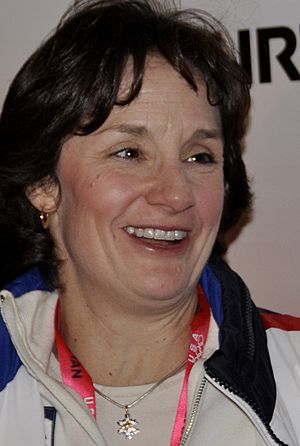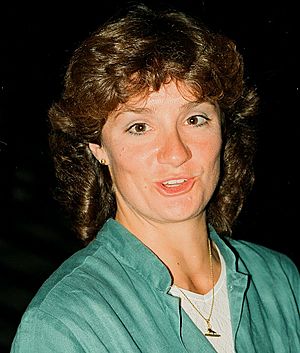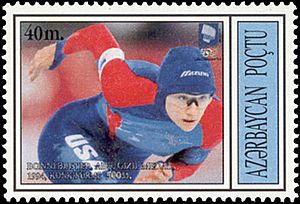Bonnie Blair facts for kids

Blair in 2010
|
|||||||||||||||||||||||||||||||||||||||||||||||||||||||||||
| Personal information | |||||||||||||||||||||||||||||||||||||||||||||||||||||||||||
|---|---|---|---|---|---|---|---|---|---|---|---|---|---|---|---|---|---|---|---|---|---|---|---|---|---|---|---|---|---|---|---|---|---|---|---|---|---|---|---|---|---|---|---|---|---|---|---|---|---|---|---|---|---|---|---|---|---|---|---|
| Born | March 18, 1964 Cornwall, New York, U.S. |
||||||||||||||||||||||||||||||||||||||||||||||||||||||||||
| Height | 5 ft 5 in | ||||||||||||||||||||||||||||||||||||||||||||||||||||||||||
| Weight | 130 lb | ||||||||||||||||||||||||||||||||||||||||||||||||||||||||||
| Spouse(s) | |||||||||||||||||||||||||||||||||||||||||||||||||||||||||||
| Sport | |||||||||||||||||||||||||||||||||||||||||||||||||||||||||||
| Country | |||||||||||||||||||||||||||||||||||||||||||||||||||||||||||
| Sport | Speed skating | ||||||||||||||||||||||||||||||||||||||||||||||||||||||||||
| Turned pro | 1984 | ||||||||||||||||||||||||||||||||||||||||||||||||||||||||||
| Retired | 1995 | ||||||||||||||||||||||||||||||||||||||||||||||||||||||||||
| Achievements and titles | |||||||||||||||||||||||||||||||||||||||||||||||||||||||||||
| Olympic finals | 1984, 1988, 1992, 1994 | ||||||||||||||||||||||||||||||||||||||||||||||||||||||||||
|
Medal record
|
|||||||||||||||||||||||||||||||||||||||||||||||||||||||||||
Bonnie Kathleen Blair (born March 18, 1964) is a famous American speed skater who is now retired. She is known as one of the best skaters of her time. She is also one of the most successful athletes in Olympic history. Bonnie Blair represented the United States in four Olympic Games. She won an amazing five gold medals and one bronze medal.
Blair first competed in the Olympics in Sarajevo in 1984. She finished eighth in the 500 meters race. At that time, Blair trained in both short-track and long-track speed skating. She even won the 1986 short-track world championship. Blair returned to the Olympics in 1988. This time, she competed in long-track at the 1988 Winter Olympics in Calgary. There, she won her first Olympic gold medal in the 500 meters. She also earned a bronze medal in the 1,000 meters.
Bonnie Blair won two more gold medals at the 1992 Winter Olympics in Albertville. She then won her final two Olympic gold medals at the 1994 Lillehammer games. Blair kept competing until 1995. The World Championships were held in Milwaukee that year. She officially retired in March 1995. After retiring, Blair became a speaker who inspires others. She has been honored in several sports halls of fame. These include the Chicagoland Sports Hall of Fame and the United States Olympic Hall of Fame.
Contents
Bonnie's Early Life and School
Bonnie Blair was born in Cornwall, New York. Her parents were Charlie and Eleanor Blair. She was the youngest of six children. Her godmother was a Canadian speed skater named Cathy Priestner. When Bonnie was a baby, her family moved to Champaign, Illinois. Bonnie first tried skating when she was just two years old. Her older brothers and sisters already enjoyed skating. She competed in her first skating event at age four.
When she was young, Blair competed in "pack style" skating. This is also called short track speed skating. In this style, several skaters race on the ice at the same time. At age seven, Bonnie won her age group at the Illinois Speed Skating Championship. She went to Jefferson Middle School and then Centennial High School in Champaign. Besides skating, Blair was also a cheerleader. She was also a member of the student council.
In 1979, Olympic medalist Cathy Priestner Faminow became Blair's coach. That's when Blair switched from pack style to long track speed skating. In long track, skaters race against the clock for the fastest time. At age 15, Blair tried out for the national team. She earned a spot on her very first try. As she focused more on the 1984 Olympics, Blair went to Europe to train. The Champaign Policemen's Benevolent Association helped pay for her training. She finished high school by mail in 1982. She then moved to the Milwaukee area. She trained there with the U.S. national speed skating team. She stayed with a family friend while she trained. Blair also took classes at Parkland College. However, training was her main focus, so she did not get a degree.
Bonnie's Amazing Skating Career
Starting Her Career and First Olympics (1984–1986)
Blair first competed internationally at the 1984 World Sprinting Championships. She finished tenth there. Later that year, at age 19, Blair went to her first Olympic Games in Sarajevo. People didn't expect her to win a medal. She later said she was just happy to be there and see her family. She did not win a medal, finishing eighth in the 500 meters. The U.S. team did not win any speed skating medals at those Olympics. After the 1984 Olympics, Blair worked hard with coach Mike Crowe. She wanted to improve her skills to compete with the strong East German skaters.
Blair did very well at the U.S. International Skating Association Metric All-Around Championships. This event was held in West Allis, Wisconsin. Her strong performance earned her a spot on the U.S. long track women's sprint team for the 1985 World Championships. Blair won both the 500 meter and 1500 meter races at the West Allis event. She was seen as one of the U.S. team's best chances for a medal. In the 1985-1986 World Cup Circuit, Blair finished fourth in four different distances. These were the 500 meter, 1,000 meter, and 1,500 meter races.
During this time, Blair trained in both short-track and long-track skating. She won events at the 1984, 1985, and 1986 short-track world championships. She was the overall short-track world champion in 1986.
Becoming an Olympic Champion (1987–1989)
In early 1987, Blair won World Cup titles in the 500 and 1,000 meters. She then set her first world record in the 500 meters. Her time was 39.43 seconds. Blair also showed she could beat the East German world champion, Karin Enke-Kania. Even though Blair was shorter, her great technique and fast start made her a tough competitor. Blair held the 500-meter world record until December 1987. That's when Christa Rothenburger beat her time at the World Cup. Blair, who was feeling sick, finished second in that race.
In December 1987, the U.S. speed skating trials for the 1988 Winter Olympics took place. Blair led the women's field in the 500, 1,000, and 1,500 meters. This secured her spot on the U.S. Olympic team, as everyone expected. Blair was considered strongest in the shorter races. People saw her as the United States' best chance for a gold medal in speed skating. The U.S. team had not won any speed skating medals in the 1984 Olympics. This added to the pressure on Blair before the 1988 games.
Blair went to the 1988 Winter Olympics in Calgary, Alberta. Her first event was the 500 meters. Rothenburger skated first and set a new world record. Blair responded with her best start ever in the 500 meters. She won the gold medal in a new world record time of 39.10 seconds. For her second event, the 1,000 meters, Blair had a personal best time. She briefly set an Olympic record. However, two competitors who skated after her beat her time. So, Blair won the bronze medal in the 1,000 meters. Blair's third and final event in 1988 was the 1,500 meters, where she placed fourth. Blair's family and friends in the stands, called the "Blair Bunch," became famous. At the end of the games, Blair was chosen to carry the American flag at the closing ceremony.
After her success, Blair took a break from skating. She started taking classes at Montana Technological University. She missed the first two World Cup events of the 1989 season. But Blair was back to competing later that season. She won the 1989 World Sprint Championships in Heerenveen, Netherlands. At this event, Blair won the 500 meters twice. She also finished third and second in two 100-meter races. This gave her the overall victory. This win made Blair the first U.S. woman to win a world sprint championship in almost ten years.
Winning More Olympic Gold (1990–1992)
The 1990–1991 season was tough for Blair. She got a bad case of bronchitis, which made it hard to breathe. This breathing problem lasted through the 1991 World Sprint Championships. She finished fifth there. Before the 1988 Olympics, people had started to lose faith in coach Crowe. So, Blair helped bring in Peter Mueller to coach the U.S. team. This coaching change happened ten months before the 1992 Olympics. Training with Mueller in the summer before the Olympics, Blair got her competitive edge back.
Blair competed again at the 1992 Winter Olympics. These games were held in Albertville, France. Even though she had won gold before, Blair felt like an underdog. She was smaller than many of the East German competitors. Blair won gold again in the 500 meters. She became the first woman to win this event in two Olympics in a row. Her winning time was 40.33 seconds. This was slower than her record in Calgary. But the Albertville venue was outdoors, which made skating conditions harder. The second-place finisher, Ye Qiaobo from China, said another skater slowed her down. China protested, but the referees did not agree. Blair dedicated her gold medal to her father, Charlie. He had passed away two years earlier. Charlie had always dreamed of Bonnie becoming an Olympic speed skater.
In her second event, the 1,500 meters, Blair finished 21st. This was partly due to her coach's plan. Her coach, Peter Mueller, told Blair he would signal her to slow down if she wasn't going to win a medal. This would let her save energy. As Blair neared the end of the race, Mueller gave the signal. Blair won her second gold medal of the 1992 Olympics in the 1,000 meters (1:21.90). Her time was just 0.02 seconds faster than Ye. With this gold, Blair became the most decorated U.S. woman in Winter Olympics history.
Her success in the 1992 Olympics brought Blair more attention. She was on the cover of Sports Illustrated. Blair also started getting more endorsement deals. After the Olympics, Blair moved to Milwaukee, Wisconsin. She trained at the new Pettit International Ice Center.
Her Last Olympics (1993–1994)
In 1986, the International Olympic Committee decided to hold the Winter Olympics and Summer Olympics in different years. So, the next Winter Games would be in February 1994. Trying to compete in her fourth Olympics was not easy. The 1993 season was not great for Blair. At the 1993 World Sprint Championships, Blair did not win any of her four races. She finished behind her rival, Ye Qiabo. Blair felt she had lost her speed. After trying to fix the problem with coach Peter Mueller, she switched to Nick Thometz. At the 1994 U.S. Olympic long-track trials, Blair set track records. She did this in the first round of the 500 meter and 1,000 meter trials.
The 1994 Winter Olympics in Lillehammer, Norway, were another big success for Blair. She won gold again in the 500 meters (39.25) and 1,000 meters (1:18.74) races. Blair finished 0.36 seconds ahead of the second-best time in the 500 meters. Her 1.38-second lead in the 1,000 meters race is the biggest lead ever in that event. Blair's success at Lillehammer made her one of the most decorated American Olympians of all time. She became the first American woman to win five Olympic gold medals. She was also the first American Winter Olympian to win six career medals. Besides the 500 and 1,000 meters, Blair also competed in the 1,500 meter race. She finished fourth, just missing a medal. At her press conference after the races, Blair confirmed that Lillehammer would be her last Olympic Games.
After the Olympics
After the 1994 Olympics, Blair continued to compete. Less than a month after the Lillehammer Olympics, Blair set another world record in the 500 meters. She became the first woman to finish the race in under 39 seconds, with a time of 38.99 seconds. Blair broke her own world record the next year. She achieved a time of 38.69 on February 12, 1995, in Calgary. Blair then went to the 1995 World Championships in her adopted hometown of Milwaukee. The "Blair Bunch," her family and friends, made up 12% of the crowd at the Pettit National Ice Center. There, Blair won the 500 meters with a time of 39.54 seconds. On March 18, 1995, she retired from skating.
In 2000, fellow speed skater Johann Olav Koss started Right To Play. He asked Blair to be one of the charity's first famous helpers. Blair became very involved with Right to Play. When the Winter Olympics returned to the United States in 2002, Blair was one of the last people to carry the Olympic flame. She carried it into Rice-Eccles Stadium for the opening ceremony in Salt Lake City, Utah. As of 2002, Blair was on the board of directors for U.S. Speedskating. As of 2014, Blair worked as a motivational speaker. She also spoke for companies. That same year, she was part of the U.S. Olympic group that went to Sochi. As of 2018, Blair is on the board of the Pettit National Ice Center.
Awards and Honors
In 1992, Blair became the third winter athlete to win the Sullivan Award. This award goes to the best amateur athlete in the United States. Blair won the 1992 Oscar Mathisen Award. She was the first female winner of this award. In 1992, Blair also received the Golden Plate Award from the American Academy of Achievement. She was named Female Athlete of the Year by the Associated Press in 1994. Blair also won the World Cup points championship 11 times. Sports Illustrated magazine named Blair their Sportswoman of the Year for 1994. By 1994, her hometown of Champaign had even renamed one of its streets Bonnie Blair Drive.
She is a member of the Chicagoland Sports Hall of Fame. She is also in the Wisconsin Athletic Hall of Fame. In 2004, she was chosen for the United States Olympic Hall of Fame. She received a special star (#7) on The Flag for Hope on September 29, 2015. This was to honor her amazing speed skating career and her charity work.
Bonnie's Family Life
Blair started dating fellow Olympic speed skater Dave Cruikshank in 1990. They got married in Milwaukee, Wisconsin in 1996. Blair and Cruikshank have two children. Their son is named Grant, and their daughter is named Blair. Grant Cruikshank played hockey at Colorado College. As of 2021, he played for the University of Minnesota. Blair's daughter competed in the 2018 United States Olympic speed skating trials. She raced in the 500-meter distance at the Pettit National Ice Center.
See also
 In Spanish: Bonnie Blair para niños
In Spanish: Bonnie Blair para niños
- List of multiple Olympic gold medalists
- List of multiple Olympic gold medalists in one event
- West Allis Speedskating Club



